The World Renowned Glorious MYSORE PALACE
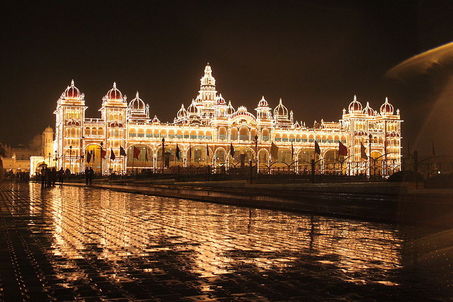
Mysore Palace is one of the most magnificent buildings. It is a sight not to be missed when it is illuminated on Sundays and festive occasions. The interior of the Palace is equally worth a visit, for its spacious halls, paintings and architectural beauty. The palace is an excellent combination of Indo-Saracenic architecture.
Mysore Palace History It is the official residence of the Wadiyars - the erstwhile royal family of Mysore, and also houses two durbar halls (ceremonial meeting hall of the royal court).
Mysore has a number of historic palaces, and is commonly described as the City of Palaces. However, the term "Mysore Palace" specifically refers to one within the old fort. The palace was commissioned in 1897, and its construction was completed in 1912. It is now one of the most famous tourist attractions in Mysore. Although tourists are allowed to visit the palace, they are not allowed to take photographs inside the palace.
Mysore Palace History It is the official residence of the Wadiyars - the erstwhile royal family of Mysore, and also houses two durbar halls (ceremonial meeting hall of the royal court).
Mysore has a number of historic palaces, and is commonly described as the City of Palaces. However, the term "Mysore Palace" specifically refers to one within the old fort. The palace was commissioned in 1897, and its construction was completed in 1912. It is now one of the most famous tourist attractions in Mysore. Although tourists are allowed to visit the palace, they are not allowed to take photographs inside the palace.
Architecture
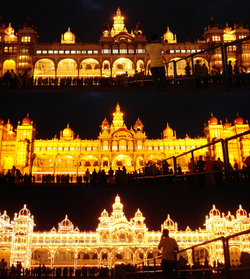
The architectural style of the palace is commonly described as Indo-Saracenic, and blends together Hindu, Muslim, Rajput, and Gothic styles of architecture. It is a three-storied stone structure, with marble domes and a 145 ft five-storied tower. The palace is surrounded by a large garden.
The three storied stone building of fine gray granite with deep pink marble domes was designed by Henry Irwin. The facade has seven expansive arches and two smaller ones flanking the central arch, which is supported by tall pillars.
Above the central arch is an impressive sculpture of Gajalakshmi, the goddess of wealth, prosperity, good luck, and abundance with her elephants.
Speical Events
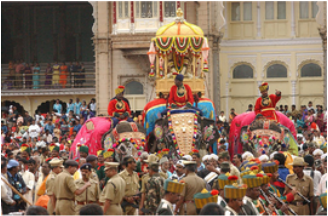
Every autumn, the Palace is the venue for the famous Mysore Dasara festival, during which leading artists perform on a stage set up in the palace grounds. On the tenth day of the festival Vijaya Dashami, a parade with caparisoned elephants and other floats originate from the palace grounds. Dasara is the most extravagant festival of Mysore. The Dasara festival is celebrated in the months of September and October of each year.
The festival celebrates and commemorates the victory of the great Goddess Durga, after she slew the demon, Mahishasura, and thereby, symbolizing the triumph of good over evil according to Hindu mythology. Some call her Chamundeshwari.
This festival has been celebrated by the Wodeyars at Srirangapatna from 1610 and in Mysore with great pomp from 1799 and the tradition still is carried on although the scale of the celebrations has diminished. The Dasara festivities have become an integral part of the culture and life in Mysore.
To celebrate this festival the Palace of Mysore is illuminated with more than 96,000 lights during that two month period.
The festival celebrates and commemorates the victory of the great Goddess Durga, after she slew the demon, Mahishasura, and thereby, symbolizing the triumph of good over evil according to Hindu mythology. Some call her Chamundeshwari.
This festival has been celebrated by the Wodeyars at Srirangapatna from 1610 and in Mysore with great pomp from 1799 and the tradition still is carried on although the scale of the celebrations has diminished. The Dasara festivities have become an integral part of the culture and life in Mysore.
To celebrate this festival the Palace of Mysore is illuminated with more than 96,000 lights during that two month period.
Temples in the Palace
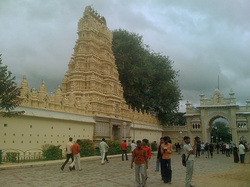
- Kodi Bharravasvami Temple – dedicated to Shiva in the form of Bhairava derives its name because of its location in the past.
- Sri Lakshmiramana Swami Temple – Oldest temple in the city. Located towards the western part of the fort, inside the Palace. An inscription found in Cole’s Gardens (present day Bannimantap) registers a Grant for God Lakshmiramana in 1499 AD. According to the annals of the Mysore Royal Family, a half blind Brahim was cured his blindness around the year 1599 at the interposition of Raja Wadiyar. The temple is also important as all the religious ceremonies in connection with coronation of child Raja Krishnaraja Wadiyar III were held in this temple on June 30, 1799.
- Sri Shweta Varahaswamy Temple - located beside the south gate. It’s constructed in the famous style of the great Hoysala Empire, which controlled most of Karnataka from the tenth until the fourteenth centuries.
- Sri Trinayaneshvara Swami Temple – Ancient temple which existed even before the time of Raja Wadiyar, located outside the Original Mysore fort, on the bank of Devaraya Sagar (Doddakere). It was during the time of Kanthirava Narasaraja Wadiyar and his successor Dodda Devaraja Wadiyar that the fort was enlarged and the Trinayaneshvara temple came within the fort.
- Sri Prasanna Krishanswami temple – The Mysore dynasty claims its descent from Yadu Vamsa (Yadu Race) founded by Sri Krishna of Mahabharata. Therefore, Krishnaraja Wadiyar III felt sad that there was no temple dedicated to Krishna. To fulfil this lacuna, he started the construction of Sri Prasanna Krishna Temple in 1825 and according to inscription, it was completed in 1829.
- Kille Venkatramana Swamy Temple – During the time of Tipu, the Mysore family was still in Srirangapatna. Queen Lakshmammanni, wife of Krishnaraja Wadiyar II was deeply worried about the dynasty and its future. Then lord Venkataramana is said to have appeared in her dream, and directed her that his statue which is in Balamuri should be consecrated in Mysore. By this pious act, her dynasty would get salvation. She therefore, proceeded to Balamuri without the knowledge of the Sultan and brought the image of Venkataramana, consecrated it in the temple, and offered continuous worship. This is said to have helped the family and after the fall of Tippu, the Kingdom was restored to the Wadiyar dynasty.
- Sri Bhuvaneshwari Temple – located on northern side of the Palace Fort corresponding to the Varahaswamy temple in the south, thus providing a symmetrical structure in the fort complex. Constructed by Sri Jayachamarajendra Wadiyar in the year 1951. One of the important objects in the temple is a copper Surya Mandala which is said to have been transferred from the Palace to this temple by His Highness Jayachamarajendra Wadiyar.
- Sri Gayatri Temple – located in the south-east corner of the fort directly corresponding to the Trinayaneshara swamy temple constructed by Jayachamarajendra Wadiyar in 1953. Three shrines dedicated to Savithri, Gayathri and Saraswathi.
Attractions
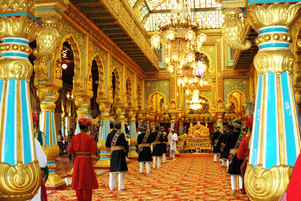
The Palace houses several rooms of importance. These include:
- Audience Chamber: This was Hall of Private Audience, where the king would confer with his ministers. It was also the chamber in which he gave audience to people deserving special attention.
- Public Durbar: The Diwan-e-aam was a public hall where the general population could meet the king at prescribed times with petitions.
- Royal wedding hall
- Armoury: The palace houses an armoury, which contains a collection of different types of arms used by the members of the royal family. These include weapons that were used in the 14th century (lances, cutlasses, etc.), as well as weapons that were used in the early twentieth century (pistols, etc.).
Time to Visit
A charge of Rs 30 is made for Adults and Rs 15 for children.
The Mysore Palace is open all days of the week, from 10 a.m. to 5:30 p.m. The palace is illuminated on Sundays, national holidays and state festivals from 7:00 p.m. to 8 p.m. The palace is illuminated between 7 p.m. to 9 p.m. only during the Dasara festival.
If you would like to treat yourself to a private guided tour of the entire palace complex, Mysore Palace Board certified tour guides can be found at the entrance to the palace. The guides will steer you to the highlights of the Mysore Palace at a nominal fee.
